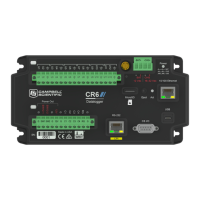9.3.1 Clock best practices
When setting the clock with LoggerNet, initiate it manually during a maintenance period when
the data logger is not actively writing to Data Tables. Click Set in the Clocks field of the
LoggerNet Connect Screen.
If you are going to use automated clock check with LoggerNet (clock settings can be found on
the LoggerNet Setup Standard View Clock tab). it is recommended that you do this on the order
of days (not hours). Set an allowed clock deviation that is appropriate for the expected jitter in
the network, and use the initial time setting to offset the clock check away from storage and
measurement intervals.
The amount of time required for a Clock Check command to reach the data logger, be
processed, and for it to send its response is called round-trip time, or time-of-flight. To calculate
an estimate of this time-of-flight, LoggerNet maintains a history (in order) of the round-trip times
for the ten previous successful clock check transactions. It adds this average to the time values
received from the data logger and subtracts it from any adjustment that it might make.
9.3.2 Time stamps
A measurement without an accurate time reference often has little meaning. Data collected from
data loggers is stored with time stamps. How closely a time stamp corresponds to the actual time
a measurement is taken depends on several factors.
The time stamp in common CRBasic programs matches the time at the beginning of the current
scan as measured by the real-time data logger clock. If a scan starts at 15:00:00, data output
during that scan will have a time stamp of 15:00:00 regardless of the length of the scan, or when
in the scan a measurement is made. The possibility exists that a scan will run for some time
before a measurement is made. For instance, a scan may start at 15:00:00, execute a time-
consuming part of the program, then make a measurement at 15:00:00.51. The time stamp
attached to the measurement, if the CallTable() instruction is called from within the
Scan() / NextScan construct, will be 15:00:00, resulting in a time-stamp skew of 510 ms.
9.3.3 Avoiding time skew
Time skew between consecutive measurements is a function of settling and integration times,
ADC, and the number entered into the Reps parameter of CRBasic instructions. A close
approximation is:
time skew = reps * (settling time + integration time + ADC time) + instruction setup
time
where ADC time equals 170 µs, and instruction setup time is 15 µs.
If reps (repetitions) > 1 (multiple measurements by a single instruction), no setup
9. Tips and troubleshooting 132

